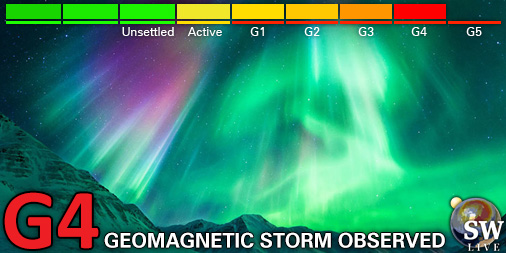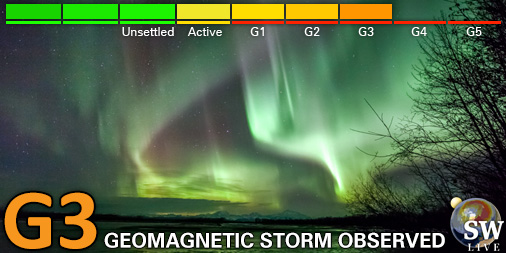Viewing archive of Tuesday, 28 October 2003
Solar activity report
Any mentioned solar flare in this report has a scaling factor applied by the Space Weather Prediction Center (SWPC). Because of the SWPC scaling factor, solar flares are reported as 42% smaller than for the science quality data. The scaling factor has been removed from our archived solar flare data to reflect the true physical units.
Report of Solar-Geophysical Activity 2003 Oct 28 2200 UTCPrepared by the NOAA © SWPC and processed by SpaceWeatherLive.com
Joint USAF/NOAA Report of Solar and Geophysical Activity
SDF Number 301 Issued at 2200Z on 28 Oct 2003IA. Analysis of Solar Active Regions and Activity from 27-2100Z to 28-2100Z
Solar activity continues at high levels. Region 486
(S17E04) produced one of the largest flares of this solar cycle, an
X17/4B proton flare peaking at 28/1110Z. This flare had intense
radio bursts including a 245 MhZ burst near 500,000 sfu and a
Tenflare of 13,000 pfu. A very fast (near 2000 km/s), earthward
directed full halo CME was observed on SOHO/LASCO imagery. Region
486, a beta-gamma-delta group with over 2100 millionths of white
light areal coverage, is now one of the largest and most complex
active regions of solar cycle 23. Region 484 (N03W68) maintains
considerable size and complexity as it approaches the west limb. It
produced occasional C-class activity and a low M-class flare at
28/1613Z. Region 488 (N08W04) continues its rapid growth and now
exceeds 800 millionths of coverage in a beta-gamma-delta
configuration. Frequent C-class flare activity was observed in this
region throughout the period. New region 493 (N09E05) was numbered
today.
IB. Solar Activity Forecast
Solar activity is expected to continue
at high levels. Region 486 in particular, has potential to produce
further major flare activity. An isolated major flare is also
possible from Regions 484 and 488.
IIA. Geophysical Activity Summary 27-2100Z to 28-2100Z
The geomagnetic field was quiet to active. A CME was observed to pass
the ACE spacecraft at around 0130Z. Solar wind speed rose to near
800 km/s, but Bz stayed northward, thwarting a significant
geomagnetic response. The X17 flare that occurred at 28/1110Z
produced proton events at greater than 10 and greater than 100 MeV
which remain in progress at this time. The greater than 100 MeV
event began at 28/1145Z with a maximum so far of 176 pfu. The
greater than 10 MeV proton event began at 28/1215Z with a maximum so
far of 6020 pfu. A polar cap absorption began at 28/1237Z and
remains in progress.
IIB. Geophysical Activity Forecast
The geomagnetic field is
expected to range from unsettled to potentially severe storming in
the next 24 to 48 hours. Today's X17 flare produced a large and fast
halo CME that will likely impact the Earth's magnetic field by
midday on day one. Past events of this magnitude have almost always
produced severe storming. The storm is expected to continue through
at least the first half of day two. Unsettled to minor storm levels
are expected on day three. The greater than 100 MeV proton event
is expected to end by day two. The greater than 10 MeV proton
event will likely persist through day three.
III. Event Probabilities 29 Oct to 31 Oct
| Class M | 90% | 90% | 90% |
| Class X | 50% | 50% | 50% |
| Proton | 99% | 99% | 75% |
| PCAF | in progress | ||
IV. Penticton 10.7 cm Flux
Observed 28 Oct 274 Predicted 29 Oct-31 Oct 270/260/250 90 Day Mean 28 Oct 124
V. Geomagnetic A Indices
Observed Afr/Ap 27 Oct 013/015 Estimated Afr/Ap 28 Oct 015/018 Predicted Afr/Ap 29 Oct-31 Oct 080/100-100/120-015/025
VI. Geomagnetic Activity Probabilities 29 Oct to 31 Oct
| A. Middle Latitudes | |||
|---|---|---|---|
| Active | 15% | 15% | 50% |
| Minor storm | 25% | 25% | 15% |
| Major-severe storm | 60% | 60% | 05% |
| B. High Latitudes | |||
|---|---|---|---|
| Active | 10% | 10% | 50% |
| Minor storm | 20% | 20% | 25% |
| Major-severe storm | 70% | 70% | 10% |
All times in UTC
Latest news
Latest forum messages
2025/04/12-13 Filament CMEs 2025/04/16 G3 Watch 480Filaments and prominences 68Coronal holes 51AR4064 9Incoming & Unnumbered Active Regions 1742
More topicsSupport SpaceWeatherLive.com!
A lot of people come to SpaceWeatherLive to follow the Sun's activity or if there is aurora to be seen, but with more traffic comes higher server costs. Consider a donation if you enjoy SpaceWeatherLive so we can keep the website online!

Latest alerts
Wednesday, 16 April 2025
21:45 UTC - Geomagnetic activity
Minor G1 geomagnetic storm (Kp5) Threshold Reached: 21:36 UTC
21:00 UTC - Geomagnetic activity
Severe G4 geomagnetic storm (Kp8) Threshold Reached: 20:55 UTC
19:45 UTC - Geomagnetic activity
Strong G3 geomagnetic storm (Kp7) Threshold Reached: 19:25 UTC
19:00 UTC - Geomagnetic activity
Moderate G2 geomagnetic storm (Kp6) Threshold Reached: 18:38 UTC
18:45 UTC - Geomagnetic activity
Minor G1 geomagnetic storm (Kp5) Threshold Reached: 18:28 UTC
Space weather facts
| Last X-flare | 2025/03/28 | X1.1 |
| Last M-flare | 2025/04/15 | M1.2 |
| Last geomagnetic storm | 2025/04/16 | Kp8- (G4) |
| Spotless days | |
|---|---|
| Last spotless day | 2022/06/08 |
| Monthly mean Sunspot Number | |
|---|---|
| March 2025 | 134.2 -20.4 |
| April 2025 | 120.7 -13.5 |
| Last 30 days | 120.8 -19.6 |







